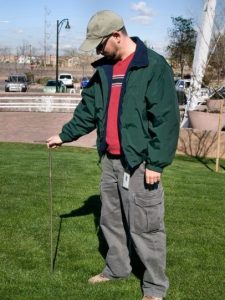The cool season brings with it the renewal of the mind and body—gone are the long, hot summer days, at least for the foreseeable future. So what better time to get out into your yard and examine the state of your irrigation system? As Water Conservation Specialists, we often see overwatering of the landscape in the fall months. Plants simply do not need as much water in the fall/winter as they do in the summer!
Saving Water = Saving Money
We all know that using less water means we will save money, but there’s an added bonus to not overwatering your yard in the cooler weather. By reducing your outdoor water use during these months, you might be able to lower your sewer rate as well. This is because cities typically recalculate your base sewer fee each fall, when it is assumed that you are using less water outdoors. Check out your water provider’s website for a further explanation on how they calculate you base sewer fee.
What’s the right way to water?
Think longer irrigation events, but less often. In the clay soils of the Sonoran desert, it can take a while for water to sink in to the soil (and adequately water plants’ roots!). This is why we suggest running your drip and sprinkler systems for longer periods of time. However, our clay soil does a great job of holding on to that water once it is saturated, hence why you and your plants can go longer in between irrigation events!

If you can start to shift your watering away from the common every day schedule, you may be surprised at the amount of water you can save, as well as the healthier looking plants that result. Plants can become yellow and fail to flower when they receive too much water.
Use this guide to determine how long to water the plants in your landscape. Once you find the appropriate length of run time—or minutes—to run each zone, all you need to change with the seasons is the days in between watering. As the weather cools, you can get away with more days in between irrigation events (see Timing is Everything for the basics of controller programming). By only adjusting the frequency of your irrigation events, but maintaining your minutes so that the root zones of the plants are adequately watered, you’ll find a healthier and more water-efficient landscape result.
For all this irrigation speak to REALLY make sense, read Landscape Watering by the Numbers. It provides you with step-by-step instructions on how to properly water your plants, based on YOUR irrigation system. You can download the PDF or request a hard copy be mailed to you.
Free Classes on Irrigation
If this article got your wheels turning on the issues facing your landscape, the cities around the Valley offer free residential landscape classes to help you even further. Check out the calendar for upcoming classes.
In addition to the classes, your water provider may provide other water conserving services, such as free water audits. Check with your local water provider for more information.
Happy watering!
From time to time, Water – Use It Wisely features guest bloggers who write about topics related to water and water conservation. The author of this blog post, Haley Paul, is a Water Conservation Specialist for the Town of Gilbert. Haley studied sustainability at Arizona State University and is passionate about helping people save water. Follow her sustainability musings on Twitter @haleyepaul.


